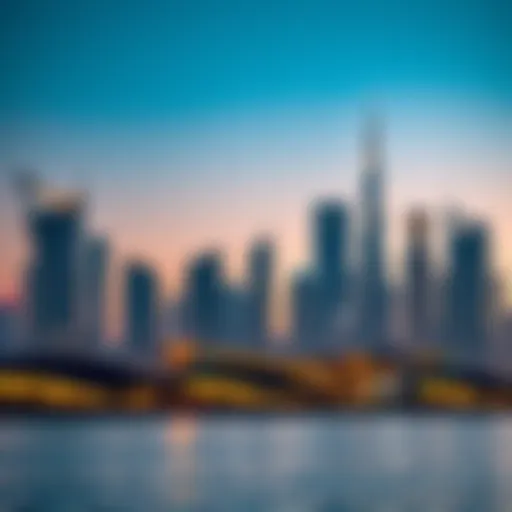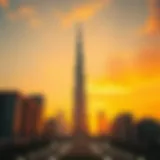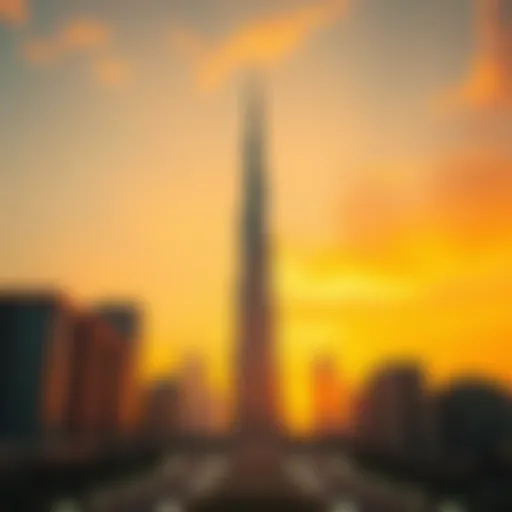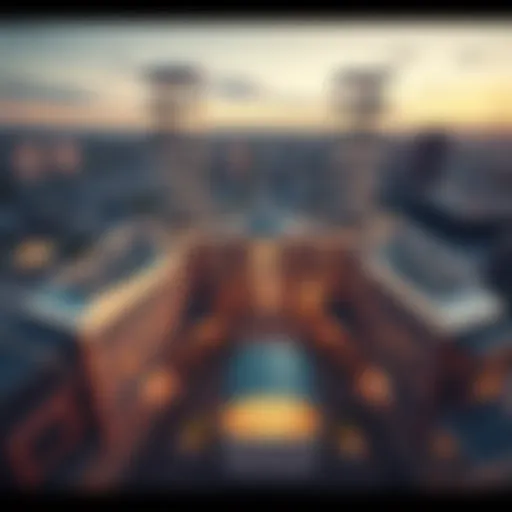The Burj Khalifa Project: Architectural and Economic Insights
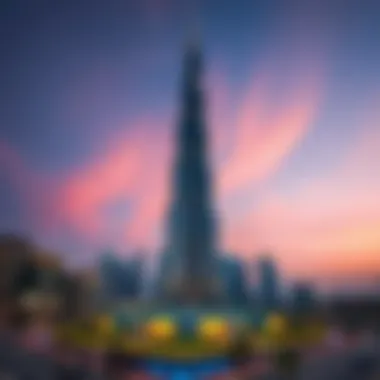

Intro
The Burj Khalifa stands tall in Dubai, not just as a sky-high architectural feat but as a symbol of modern ambition and economic evolution. A closer look reveals more than just a towering building; it's an embodiment of a city's aspirations and a reflection on market trends that ripple through the real estate fabric of the region. To grasp the full scope of the Burj Khalifa's influence, it's essential to understand both its architectural marvel and the economic waves it has generated.
Market Trends
Current Market Analysis
In the heart of one of the fastest-growing cities in the world, the Burj Khalifa is a beacon attracting investors, tourists, and residents alike. Current market dynamics indicate that real estate in Dubai is not just about owning a piece of land, but about investing in a lifestyle. The areas surrounding the Burj Khalifa, like Downtown Dubai, have shown a steady increase in real estate prices, driven by the building’s iconic status and the luxury it represents.
"The Burj Khalifa isn't just a building; it's a catalyst for Dubai's status as a global city."
One notable aspect is the rise of luxury condos and commercial spaces. The demand for high-end living spaces has surged, leading to a boom in developments that echo the elegance and prestige of the Burj Khalifa. Investors are keen to latch onto this trend, as properties in close proximity to the tower seem to hold their value and often appreciate rather swiftly. Furthermore, the influx of businesses looking to establish roots near the Burj indicates a bustling environment ripe for economic growth.
Future Predictions
Looking ahead, the projections for Dubai's real estate market are generally positive. With ongoing infrastructure developments and events such as Expo 2020, there’s a palpable buzz around the city’s ability to attract global attention and investment. Analysts suggest that areas adjacent to the Burj Khalifa might very well continue to see a surge in both commercial and residential prices. Additionally, as sustainability becomes a focal point in architecture, future projects may follow the Burj's lead in incorporating green technologies, making them more attractive to eco-conscious investors.
Investment Opportunities
High-Return Areas
Locations near the Burj Khalifa are often highlighted as prime targets for investment. Properties like the Address Downtown and other luxury hotels frequently report significant returns on property investment, often double that of lesser-known neighborhoods. The region's status as a magnet for international tourism only enhances its appeal, ensuring year-round occupancy rates that investors often dream about.
- Burj Vista: Known for stunning views and proximity to the tower itself, this area appeals to buyers looking for a mix of luxury and convenience.
- Downtown Dubai: A constant hotspot, characterized by its buzzing nightlife and shopping, it's a place where investments can pay off significantly.
Emerging Neighborhoods
As Dubai transforms, new neighborhoods are cropping up with investments reminiscent of the boom driven by the Burj Khalifa's inception. Districts such as Dubai Creek Harbour and Dubai Hills Estate are gaining traction as investors seek opportunities in up-and-coming areas. While these neighborhoods might not yet have the iconic allure of the Burj Khalifa, they are rapidly developing and promise high returns in coming years. Investors keen to jump on the bandwagon now could find themselves seated atop a goldmine when property values shift upward.
In summary, the Burj Khalifa stands not only as a marvel of architecture but also as a pivotal player in Dubai's real estate market landscape. Its influence will continue to shape economic trends and redefine investment strategies for years to come.
Preamble to the Burj Khalifa Project
The Burj Khalifa stands as a monumental achievement in the realm of architecture and engineering. More than just a tall building, it serves as a beacon of ambition, innovation, and the relentless pursuit of progress. Understanding the significance of the Burj Khalifa is essential, as it encapsulates the rapid transformation of Dubai from a modest port city to a global metropolis. This iconic structure not only redefines the skyline of the city but also influences the broader conversation about architectural sustainability, economic growth, and urban planning.
Historical Context
When tracing back the roots of the Burj Khalifa, one must consider the socio-economic landscape of Dubai in the late 20th century. Initially a trading hub, the emirate sought to diversify its economy away from oil dependency. The establishment of the Burj Khalifa was not merely a design exercise; it symbolized a potent mix of ambition and adversity.
In 2004, the construction of the Burj was a statement of intent. It was part of the larger development initiative known as the Downtown Dubai project, which aimed to create a vibrant community integrating commercial, residential, and recreational spaces. The history of the site is rich and layered, once home to small residential neighborhoods and markets that were bustling with local life. The visionaries behind this project understood that the Burj Khalifa could serve as a catalyst for tourism and investment, attracting both foreign and local interest in Dubai as a new financial hub.
Significance in Dubai's Urban Development
The Burj Khalifa’s importance in shaping Dubai’s urban development cannot be overstated. It represents much more than architectural prowess; it’s a manifestation of Dubai's aspiration to be a leader on the world stage. Unlike traditional skyscrapers that often serve as mere office spaces, the Burj is a mixed-use structure housing luxury residences, corporate suites, and a top-notch hotel.
The building’s role in urban development is multifaceted:
- Catalyst for Growth: The construction of the Burj Khalifa spearheaded various other developments in Downtown Dubai, including retail, hotels, and entertainment facilities. The area has become a bustling urban center attracting global tourists and residents.
- Real Estate Boost: Its presence has significantly increased property values in adjacent neighborhoods, transforming the real estate market in Dubai. Investors see the Burj Khalifa as a symbol of stability and prestige, prompting more robust investment inflow.
- Cultural Identity: Beyond its economic contributions, the Burj Khalifa shapes the cultural narrative of the city. It has become an emblem of modernity and ambition, inspiring other cities to pursue architectural innovations.
As the tallest structure in the world, the Burj Khalifa has undoubtedly carved a unique niche, serving as a blueprint for future skyscrapers worldwide while reminding the world of Dubai's thrilling ascent.
Architectural Vision and Design
The architectural vision and design of the Burj Khalifa rest at the heart of its identity, shaping not only its physical presence in the Dubai skyline but also its overall significance in the context of contemporary architecture. This section delineates the key design considerations, influences, and innovations that converge to create the tallest structure in the world.
Design Inspiration and Aesthetics
The Burj Khalifa's design draws upon a rich tapestry of influences, most notably the Islamic architecture that permeates Dubai's cultural landscape. Its Y-shaped floor plan was developed to optimize views and natural lighting while also providing structural stability. This aesthetic choice is, in many ways, a nod to traditional Islamic motifs, which often emphasize geometric patterns and symmetry. The silhouette of the building, lifting upwards in a soaring fashion, mimics the shape of a desert flower, which reflects not only local flora but also the resilience of nature in the arid environment.
Furthermore, the cladding of the Burj, made primarily from reflective glass and polished stainless steel, ensures that the tower interacts dynamically with the surrounding sunlight. As a result, from dawn to dusk, the Burj changes its appearance and color, presenting the city with an ever-evolving visual spectacle. This kind of architectural expression resonates deeply with both locals and visitors, creating a vibrant dialogue between the structure and its environment.
Architectural Firms Involved
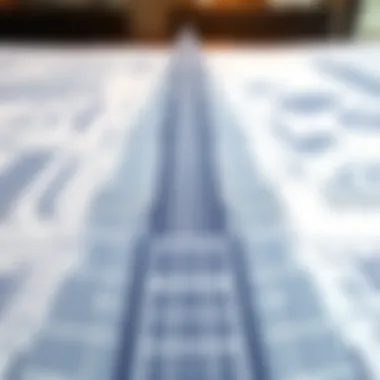

The visionary design of the Burj Khalifa was executed by the renowned architectural firm, Skidmore, Owings & Merrill, with lead designer Adrian Smith spearheading the project. This firm is no stranger to height—having been behind other skyscrapers like the Willis Tower and One World Trade Center. Collaborating closely with local entities such as Emaar Properties, Skidmore, Owings & Merrill infused the construction with both global architectural insights and local sensibilities, creating a harmonious blend that is distinctly Dubai.
Additionally, the engineering prowess of Billie C. K. Wong, responsible for the structural engineering, helped realize a vision ambitious in both height and complexity. The collaboration among these firms illustrates the necessity of diverse expertise in undertaking such monumental projects, ensuring that every element, from structure to aesthetics, works in concert to achieve the overall vision.
Innovations in Building Design
Innovation stands as a cornerstone of the Burj Khalifa's architectural journey. The tower incorporates a plethora of state-of-the-art technologies and methodologies. For instance, the high-performance exterior not only serves aesthetic purposes but also aids in energy efficiency, reducing heat gain through its reflective surfaces. One of the remarkable techniques utilized in its construction is the "buttressed core" design, allowing for a significantly tall structure without sacrificing stability.
Furthermore, the installation of the elevated sky lobbies exemplifies practicality within lofty designs, facilitating vertical transportation in a manner that is efficient and strategic. Technologies like high-speed elevators, which travel at speeds of up to 10 meters per second, enhance the experience of navigating through such an impressive structure. These innovations have ripple effects within the building industry, influencing upcoming architects and developers to push the boundaries of what's possible in design and construction.
In summary, the architectural vision behind the Burj Khalifa encapsulates a blend of cultural reverence and modern innovation. By harmonizing design inspiration with technological advancements and expert collaborations, this iconic structure not only defines the skyline of Dubai but also stands as a symbol of the architectural capabilities of our time.
"The Burj Khalifa is not just a building; it represents the aspiration and ambition of a city reaching for the stars."
For further resources and a deeper dive into these architectural insights, you may explore Skidmore, Owings & Merrill, Emaar Properties, and educational content available on Wikipedia.
Engineering Marvels: Construction Techniques
The Burj Khalifa stands as a testament to exceptional engineering and innovation. The intricacies of its construction techniques embody both ingenuity and meticulous planning, which are critical elements in establishing such an iconic structure. This section delves into the specifics of how these engineering marvels not only ensured the safety and viability of the skyscraper but also facilitated its breathtaking presence in the Dubai skyline.
Foundation and Structural Integrity
The Burj Khalifa's foundation is truly remarkable, showcasing advanced engineering solutions that deal with the challenges posed by Dubai's subsoil conditions. Given that the region has a high water table, special attention was needed to design a secure base for this towering edifice. The building sits on a massive reinforced concrete mat, which is 3.7 meters thick and rests upon bored piles that reach down to solid bedrock. This arrangement provides stability and minimizes the risk of settling or shifting over time.
The iconic structure employs a unique design called a "buttressed core." This configuration consists of three wings that extend from the central core, forming a Y-shape, which helps distribute stresses efficiently while maintaining an elegant profile. The design not only respects architectural aesthetics but also significantly boosts the overall structural integrity.
Materials Used in Construction
Among the standout aspects of the Burj Khalifa's construction is its innovative use of materials. The skyline-altering structure is primarily fashioned from reinforced concrete, a fitting choice for its height and resilience. The concrete mixtures were specially formulated to withstand the extreme forces exerted at such an altitude, ensuring durability in the face of local weather conditions. Moreover, glass and steel were meticulously selected to create the facade. The glass panels are treated for solar reflectivity, and alongside the structural steel framework, they aid in regulating temperature within the building. This careful selection of materials contributes to the building’s sustainability initiatives and dramatically impacts energy efficiency.
Challenges Faced During Construction
Building the Burj Khalifa was no walk in the park; a multitude of challenges arose that tested the limits of contemporary engineering. High winds presented a major hurdle during construction and post-completion, with gusts that could sway the structure significantly. Engineers had to factor this into the design, implementing aerodynamic forms to counteract wind loads effectively. Additionally, logistical challenges emerged while transporting materials to the construction site. Given the building's extensive height, cranes had to be specially designed and meticulously positioned to facilitate material movement at heights that would strain typical equipment. This prudent planning and responsive adaptation to on-site conditions allowed construction to proceed without major disruptions or delays.
"The Burj Khalifa does not just rise above the city – it pushes the limits of what skyscrapers can achieve in both form and function."
In summary, the engineering methods employed in constructing the Burj Khalifa are not merely technical feats; they reflect a harmonization of art and science. Through thoughtful design, innovative materials, and a strategic approach to overcoming challenges, the Burj Khalifa remains a beacon of architectural excellence and engineering prowess in the modern world.
Economic Impact on Dubai
The Burj Khalifa, soaring to unprecedented heights, encapsulates not just the ambition of a city but also its economical vibrancy. As an architectural masterpiece, its influence stretches far beyond its shimmering glass façade. This section delves into how the Burj Khalifa has played a pivotal role in reshaping Dubai’s economic landscape, fundamentally altering its real estate markets, boosting tourism, and creating numerous employment opportunities.
Boosting the Local Real Estate Market
With its awe-inspiring height, the Burj Khalifa has become a magnetic hub for real estate investment within Dubai. The skyscraper has significantly raised property values in its immediate vicinity, transforming the surrounding area into one of the most sought-after real estate markets in the city.
- Attraction for Investors: The high-profile nature of the Burj Khalifa has drawn in investors, both local and international, looking to capitalize on a dynamic urban market. Properties near the tower often command premium prices, an indicator of the tower's intrinsic value to the market.
- Luxury Developments: The area surrounding the Burj Khalifa saw a surge in luxury developments, attracting affluent buyers and tenants. This trend has led to a notable increase in economic activities related to real estate services, further stimulating the local economy.
- Infrastructure Development: Investment in infrastructure around the Burj Khalifa has also amplified, with improved transport links and amenities. High-end malls, hotels, and restaurants have sprouted, enhancing the neighborhood's appeal.
Tourism and Global Recognition
The Burj Khalifa stands as a beacon of tourism in Dubai. It draws millions of visitors each year, making it one of the city's most recognizable landmarks.
"The Burj Khalifa is not just a sight to behold; it’s a testament to what modern architecture can achieve," an architect once remarked.
- Foot Traffic: The influx of tourists generates tremendous foot traffic, leading to increased revenue for businesses. From the observation decks offering breathtaking views to the lavish dining experiences on-site, the Burj Khalifa significantly boosts Dubai's tourism economy.
- Brand Dubai: Internationally, the tower serves as a brand ambassador for Dubai. When people think of Dubai, they often envision this skyscraper, which enhances the city's profile on the global stage. The resultant recognition attracts worldwide events, conferences, and exhibitions.
- Cultural Impact: Cultural events hosted in areas around the Burj Khalifa, such as festivals and concerts, further bolster tourism. Each event translates into wider economic benefits for local businesses, showcasing the intertwining of tourism and economy effectively.
Job Creation and Economic Growth
As a monumental endeavor, the construction and maintenance of the Burj Khalifa has had a substantial impact on job creation within Dubai.
- Construction Jobs: At its peak, thousands of workers were employed directly on the construction site, with many others in associated industries such as material supply, logistics, and project management. This surge in employment during the construction phase provided significant financial boosts to local communities.
- Long-Term Employment: After the tower's completion, job opportunities extended to sectors such as hospitality, retail, and maintenance services. The businesses that flourished in the area created a diverse job market catering to a variety of skill sets.
- Economic Growth: The overall economic growth resulting from the Burj Khalifa stretches beyond immediate job numbers. The prosperity seen in the real estate and tourism sectors has contributed to increased consumer spending, thereby amplifying the overall economic pulse of Dubai.
In summary, the Burj Khalifa is not merely an architectural wonder but a cornerstone of Dubai’s economic framework. Its profound impact on real estate, tourism, and employment illustrates how a single structure can serve as a catalyst for broader economic trends, setting a precedent for future iconic structures around the world.
Cultural Significance


The Burj Khalifa isn’t just a towering structure; it’s a powerful symbol that embodies the aspirations and ethos of modern Dubai. Its architectural grandeur and economic ramifications interweave to form a significant cultural tapestry. Understanding its cultural significance involves delving into two main facets: its role as a beacon of modernity and its representation of a national identity.
Symbol of Modernity
With its striking silhouette piercing the Dubai skyline, the Burj Khalifa stands as a testament to human ambition and architectural innovation. It redefines what a skyscraper represents in the contemporary world.
- Architectural Feat: The Burj Khalifa’s design is not only about height; it incorporates cutting-edge technologies and sustainable practices that set new benchmarks for skyscrapers worldwide. Its construction employed techniques never seen before, such as a specially-designed buttressed core that ensures both strength and elegance.
- Global Influence: It has become a template for urban development and a model for architectural competitions. Cities around the world observe and adapt ideas from the Burj Khalifa, seeking to mirror its success in projecting city identity.
Famed architect Adrian Smith, who designed the towering icon for Skidmore, Owings & Merrill, intended it to reflect Islamic architecture while integrating contemporary styles. The building also draws visitors and investors from every nook and cranny of the globe, further solidifying its status as a modern marvel.
"The Burj Khalifa is not just a building; it's an icon that reshapes perceptions and inspires future generations to dream bigger."
Representation of National Identity
The Burj Khalifa serves as a powerful symbol of UAE's cultural aspirations, embodying both its past and its future.
- Cultural Heritage: The intricate patterns and designs found in the building mirror traditional Islamic art, elegantly tying the modern with the historical. Visitors often remark on how this blend enhances the cultural tapestry of Dubai.
- National Pride: As the tallest building globally, it stands as a source of pride for Emiratis, signifying their rapid development and economic prowess. It’s not merely a structure, but a statement that showcases the UAE’s journey from a collection of modest fishing villages to a key player in the global economy.
Moreover, the Burj Khalifa acts as a catalyst for national celebrations and cultural events, ranging from fireworks displays during New Year’s Eve to other significant festivities. These events signify unity and pride among citizens, further entrenching the building’s role in the national consciousness.
Marketing and Branding Strategies
The Burj Khalifa stands not only as an architectural marvel but also as a pivotal case study in the realms of marketing and branding strategies. This section will explore how effectively positioning the Burj Khalifa transformed it into a global icon and the intricacies of collaborating with tourism boards to bolster its recognition. These strategies aren't merely buzzwords; they play a significant role in cultivating an appealing image that resonates with investors, tourists, and the local populace alike.
Positioning the Burj as a Global Landmark
When it comes to marketing a skyscraper like the Burj Khalifa, positioning plays a vital role. The goal was not just to create another tall building, but to craft an identity that exudes luxury, modernity, and aspiration. By branding it as the world’s tallest building, the developers positioned the Burj Khalifa to attract a diverse array of visitors and investors, creating a flagship project that other developments could aspire to replicate.
To achieve this positioning, several key factors were leveraged:
- Exclusive branding: The Burj Khalifa isn’t just a location; it’s an experience. The idea of luxury permeates every aspect of the building, setting high expectations for its visitor demographic.
- Global reach: Marketing strategies incorporated international media outlets to share the story of the Burj’s development, construction, and grand opening, making sure that the narrative reached far and wide.
- Visual identity: Opting for striking visuals in all promotional materials helped in creating a cohesive brand image. Images of the Burj illuminated at night or framed against the fireworks on New Year's Eve convey grandeur and scale.
A strategic emphasis here was the emotional connection cultivated through storytelling, enhancing the building's allure while resulting in elevated foot traffic and high-profile events.
“In positioning the Burj Khalifa as an icon rather than just a structure, the developers capitalized on the emotional aspirations of success inherent in towering skyscrapers.”
Collaboration with Tourism Boards
In tandem with establishing the Burj Khalifa as a landmark, effective collaboration with tourism boards significantly boosted its visibility. Partnering with these entities not only increased marketing reach but also aligned the skyscraper with Dubai’s overall branding efforts.
Key aspects of this collaboration include:
- Joint marketing campaigns: By pooling resources with tourism boards, promotional efforts focused on the Burj Khalifa were amplified, reaching potential tourists directly through travel guides, online platforms, and international conventions.
- Incentives for visitors: Packages that combine visits to the Burj Khalifa with other local attractions encouraged longer stays and greater spending in Dubai, effectively creating a win-win scenario.
- Cultural positioning: The partnership allowed for the Burj Khalifa to be integrated into cultural narratives, making the visit not just about the tallest building, but also about experiencing modern Arabian architecture at its finest.
Through these collaborative efforts, tourism boards were able to enhance the socio-economic fabric of Dubai, while the Burj not only became a point of interest but a focal point in marketing Dubai as a premier global tourist destination.
As we conclude this section on marketing strategies, it's clear that the Burj Khalifa’s success is a testament to strategic branding and collaboration. By understanding their market and enlisting the right partners, stakeholders ensured that this skyscraper became more than just a component of the Dubai skyline—it became a global symbol of aspiration.
Residential and Commercial Spaces within the Burj
The Burj Khalifa is not just an architectural spectacle; it also incorporates essential residential and commercial spaces that significantly enhance its role in Dubai's urban tapestry. An understanding of these spaces reveals much about the lifestyle and economic dynamics within the tower and the city itself. The design intricacies and functionalities of these spaces cater to a unique blend of luxury and practicality, attracting a varied clientele.
Luxury Living in the Skyscraper
Living in the Burj Khalifa is akin to being on top of the world—literally. The residential component comprises 900 private residences, which include one, two, and three-bedroom apartments, along with a few exclusive penthouses that redefine luxury. Each unit is thoughtfully designed, boasting floor-to-ceiling windows that not only flood the spaces with natural light but also provide breathtaking views of the city skyline and the Arabian Gulf. Additionally, these apartments feature high-end finishes, smart home technologies, and access to exclusive amenities, such as a private swimming pool and a health club.
Beyond the mere aesthetic appeal, the apartments offer a certain lifestyle that is hard to match. The convenience of living in such a central location allows residents to enjoy proximity to world-class dining, luxury shopping districts, and cultural landmarks. This unique lifestyle attracts both local affluent individuals and expatriates looking for a taste of the high life.
Commercial Opportunities Offered
The commercial space within the Burj Khalifa is equally impressive and serves as a hub for various businesses ranging from multi-national corporations to startups. Lower floors of the tower are designated for office space, featuring cutting-edge facilities that are conducive to a modern working environment. These offices come equipped with advanced telecommunications and multiple high-speed internet access points, making it an ideal location for businesses aiming for high visibility in the heart of Dubai.
Moreover, the commercial sector of the Burj Khalifa is infused with high-footfall retail spaces that cater not just to residents but to the millions of tourists who flock to the structure every year. The presence of fine dining restaurants, art galleries, and boutique shops within the tower offers a unique value proposition. Business owners benefit from the immense visibility and accessibility that a landmark of such stature brings, making it a lucrative choice.
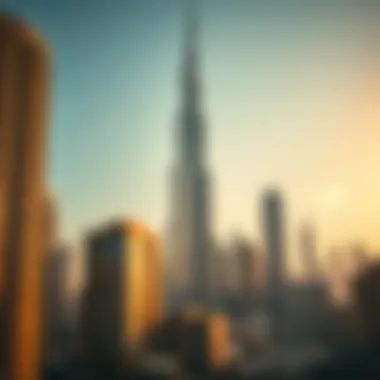

"The Burj Khalifa stands as not just a feat of engineering but a vital component of Dubai's economic fabric, melding residential and commercial spaces in a way that creates a vibrant urban environment."
Sustainability Efforts
Sustainability is a cornerstone of modern architecture, especially for landmarks as prominent as the Burj Khalifa. As cities expand and the world grapples with climate change, the responsibility of constructing eco-friendly structures has never been more critical. The Burj Khalifa not only serves as a symbol of Dubai's aspirations but also demonstrates how sustainability can weave seamlessly into large-scale construction projects.
Green Building Initiatives
The Burj Khalifa stands out in its commitment to adopting green building initiatives. These initiatives are not mere additions but form a crucial part of the design and operational philosophy. For starters, the building incorporates a double-glazed curtain wall system, which reduces heat gain while maximizing natural light. Such use of advanced glazing technology helps in maintaining comfortable indoor temperatures, reducing reliance on air conditioning.
Moreover, rainwater harvesting is another significant practice implemented here. The structure is designed to collect rainwater, which is then utilized for landscaping and other non-potable needs within the complex. This not only conserves precious water resources but also minimizes the building’s environmental footprint.
In addition to these techniques, the Burj Khalifa includes landscaped terraces and a central park, which helps in enhancing biodiversity in an otherwise arid environment. By incorporating greenery into the design, the project contributes to urban wildlife habitats while also providing spaces for residents and visitors to enjoy.
"The Burj Khalifa isn't just a marvel in height; it's a testament to how tall structures can coexist with nature."
Energy Efficiency Measures
Energy efficiency measures are another critical aspect of the Burj Khalifa’s sustainability efforts. The building employs several innovative technologies aimed at reducing energy consumption. For instance, the high-efficiency air conditioning systems use variable refrigerant flow, allowing for optimized use depending on occupancy levels, thus minimizing unnecessary energy waste.
Lighting also plays a vital role in energy efficiency. The use of LED lighting throughout the building significantly reduces electricity demand compared to traditional lighting systems. These measures combine to ensure that the Burj Khalifa operates with a remarkable energy efficiency ratio, setting a benchmark for future developments.
Furthermore, the integration of advanced building management systems allows real-time monitoring and adjustment of energy usage, thereby minimizing environmental impacts. The green initiatives and energy efficiency measures illustrate how the Burj Khalifa not only seeks to impress through its towering stature but also through its commitment to a sustainable future.
In recognizing the importance of both environmental sustainability and energy efficiency, the Burj Khalifa sets a precedent for future iconic structures. This is a vital lesson that investors, analysts, and developers should take to heart as urban landscapes continue to evolve.
For more details on energy-efficient building practices, visit the U.S. Department of Energy.
Future of Iconic Structures in Urban Landscapes
As we look at the horizon of urban architecture, it becomes evident that the emergence of iconic structures like the Burj Khalifa is not merely a trend; it's a fundamental shift in how cities perceive and implement their architectural identities. These towering edifices are not just functional buildings; they act as landmarks and symbols of progress, shaping both the populace and the economy. Here, we will examine the significance of these structures in urban landscapes, weighing their benefits and considerations for future developments.
Lessons from the Burj Khalifa
When observers gaze up at the Burj Khalifa, they often think about its height or the architectural prowess it represents. However, the lessons drawn from its development extend far beyond aesthetics. Some of the key takeaways are:
- Integration of Technology: The Burj Khalifa showcases how technology can enhance structural integrity while promoting sustainability.
- Mixed-Use Environments: Combining residential, commercial, and leisure spaces creates vibrant communities, setting a blueprint for future skyscrapers.
- Cultural Expression: Architectural design should reflect local heritage while also embracing modernity, striking a balance that appeals to both residents and tourists.
An example of this integration is the use of high-performance glass that not only reduces energy costs but also minimizes glare, proving that smart design is both practical and visually appealing. In this regard, the Burj Khalifa stands as a teacher, imparting knowledge that can help guide future iconic structures in balancing form, function, and cultural identity.
Impact on Future Developments
The iconic stature of the Burj Khalifa is likely to echo throughout the architectural landscape for years to come. As global cities increasingly strive to define their identity, the implications of its existence are worth noting:
- Skyline Transformations: New projects are likely to focus on height and innovative designs, aiming to dominate the skyline like the Burj Khalifa does for Dubai.
- Economic Engines: Future iconic structures will not only induce tourism but also stimulate local economies by fuelling job creation and drawing business investments.
- Sustainability Focus: As climate change becomes an ever-pressing concern, subsequent developments will need to incorporate advanced sustainability measures, echoing the eco-conscious practices initiated by the Burj Khalifa's planning.
Cities worldwide can observe that iconic structures like the Burj Khalifa have the potential to reshape urban landscapes. Moving forward, as architectural trends continue to evolve, property investors, real estate agents, and urban planners will find themselves at the crossroads of innovation, sustainability, and cultural significance.
"The Burj Khalifa does not simply touch the sky - it redefines what the sky means for urban landscapes."
End
The Burj Khalifa stands not only as a feat of architectural prowess but also as a touchstone for urban development and economic growth in Dubai. In discussing its legacy, we must reflect on several critical elements that resonate through the fabric of both the city and global architecture.
Reflections on the Burj Khalifa’s Legacy
Shake the Foundation of Expectations: The Burj Khalifa shattered preconceived notions of skyscrapers. Its record-breaking height stretched not just upwards but also peoples' imagination, prompting a reimagining of what is architecturally possible. Amidst the sea of buildings that define skylines, the Burj emerges as a leader, influencing other high-rises around the world like the Shanghai Tower and the One World Trade Center.
- Bold Design Inspirations: The building's design was influenced by the hymenocallis flower, reflecting nature’s intricacy in urban environments. This attention to natural essences invites a dialogue between the constructed and natural worlds, leading future constructions to similarly embrace organic elements.
- Economic Catalyst: The Burj Khalifa served as a magnet for investment, stimulating both local and international interest in Dubai's real estate market. Its presence has enhanced property values in its vicinity, making it a cornerstone of fresh developments, including residential and commercial spaces.
"In the world of skyscrapers, it is not merely the height that matters but the heart behind their construction."
- Cultural Icon: Beyond commerce and tourism, the Burj Khalifa signifies cultural pride for the UAE, embodying the aspirations and dynamic spirit of its people. It has become a focal point for national celebrations, further solidifying its place in the social fabric of Dubai.
As we contemplate the future of architectural endeavors, the lessons gleaned from the Burj Khalifa underscore the necessity for innovation and sustainable practices. Its legacy is not bound just to structure and aesthetics but extends into how cities can foster identity, community, and economic resilience.
In summary, the Burj Khalifa holds a vibrant legacy that fuels inspiration, challenges norms, and serves as a beacon for future urban developments. By diving deep into its architectural and economic impact, readers not only witness a landmark but also the very evolution of urban living in the modern age.
For additional insights on this subject, consider visiting resources such as Wikipedia and Britannica.
A reflection on such an iconic structure leaves us pondering: what will the next skyscrapers teach us about our aspirations?



